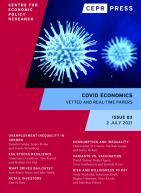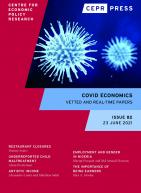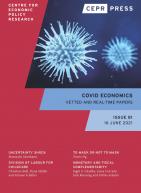
This paper investigates telework in Japan during the spread of COVID-19. Using unique survey data, we show which occupations are suited to telework. Our results show that the use of telework increased from 6% in January to 10% in March and reached 17% in June 2020, although remarkably the level is still lower than that of other developed countries (e.g. 37% in Europe). Furthermore, we found that some occupations such as services with face-to-face communication are the most unsuitable for telework. They tended to suffer from negative impacts, such as largely reduced incomes and working hours.
Citation
Okubo, T (2020), ‘Spread of COVID-19 and Telework: Evidence from Japan‘, COVID Economics 32, CEPR Press, Paris & London. https://cepr.org/publications/covid-economics-issue-32#392514_392908_390527
We study the market reactions following staggered lockdown events across U.S. states during Covid-19. We find that returns on firms located in lockdown states are higher following the lockdown. We interpret these market reactions as reflecting updated beliefs of market participants in the light of events that follow the lockdowns, such as compliance with stay-at-home orders. The effect is (a) only significant when the firm’s county has a high number of infections, (b) larger for firms in essential industries, and (c) larger for states with Democratic trifecta. While lockdown extension announcements are associated with negative market reactions, the reaction is still positive when the county’s number of infections is high. These findings suggest that the market perceives Non-Pharmaceutical Interventions, when effective, to be beneficial for businesses.
Citation
Xia, Y, S Dasgupta, T Huynh and C Chen (2020), ‘Were Stay-at-Home Orders During Covid-19 Harmful for Business? – The Market’s View‘, COVID Economics 32, CEPR Press, Paris & London. https://cepr.org/publications/covid-economics-issue-32#392514_392908_390817
After fitting a topic model to 79,597 COVID-19-related paragraphs in 11,183 conference calls over the period January to April 2020, we obtain measures of firm-level exposure and response to COVID-19 for 3,019 U.S. firms. We show that despite many different ways through which COVID-19 affects their operations, firms with a strong corporate culture do better in the midst of a pandemic than their peers without a strong culture. Moreover, firms with a strong culture are more likely to emphasize community engagement and adopt digital technology, and are no more likely to engage in cost cutting than their peers without a strong culture. To explore the channels through which culture makes firms resilient to the pandemic, we show that firms with a strong culture have higher sales per employee and lower cost of goods sold per employee during the first quarter of 2020. Our results provide support for the notion that corporate culture is an intangible asset designed to meet unforeseen contingencies as they arise (Kreps 1990).
Citation
Zhang, T, X Liu, F Mai and K Li (2020), ‘The Role of Corporate Culture in Bad Times: Evidence from the COVID-19 Pandemic‘, COVID Economics 32, CEPR Press, Paris & London. https://cepr.org/publications/covid-economics-issue-32#392514_392908_390528
The literature has long documented social capital as a key social determinant of health. However, because personal social interactions are implicated in the spread of viral infections, areas with high levels of social capital may have been especially at risk during the early phases of the COVID-19 pandemic when spread could not be halted by behavioral changes. We analyzed data from US counties on laboratory-confirmed COVID-19 cases and COVID-19 deaths and relate county level social capital with the number of days it took a county to reach 10 or 15 cases (from January 22) and with case fatality rate in the county between January 22 and May 8 2020. From January 22 on average it took 68 days for a county to reach at least 10 COVID-19 cases. Disease spread was faster the higher the social capital in a community. In counties with average levels of social capital 10 cases were identified by March 29, but in counties with social capital one SD above the average 10 cases were identified by March 26. The difference is equivalent to the difference estimated across two counties that differ in population density by 12,000 people per square mile. Other things being equal we estimate lower case fatality in higher social capital counties, with a reduction of between 0.2% and 0.4% points per SD difference in social capital. As governments lift mandatory social distancing, social capital may play a key role as a social determinant of health.
Citation
Borgonovi, F, S Subramanian and E Anieu (2020), ‘Community Level Social Capital and COVID-19 Infections and Fatality in the United States‘, COVID Economics 32, CEPR Press, Paris & London. https://cepr.org/publications/covid-economics-issue-32#392514_392908_390529
The COVID-19 pandemic has led to considerable changes in retail shopping. There has been a significant increase in online shopping compared to on-premise, but due to social distancing and other safety regulations, there have also been significant changes in how on-premise retail is conducted. Prior studies have demonstrated significant effects on product-market concentration from the move to more online shopping, but here we focus on the effects on concentration due to the common change of moving from self-service stores to counter-service. Using a pre-COVID field experiment of a move in the opposite direction, our results suggest that an increase in counter-service shopping is likely to increase product-market concentration, potentially overwhelming the opposite change from the move to online shopping.
Citation
Samila, S, B Silverman and A Goldfarb (2020), ‘COVID, on-premise retail format, and product-market concentration‘, COVID Economics 32, CEPR Press, Paris & London. https://cepr.org/publications/covid-economics-issue-32#392514_392908_390530
This paper shows that the labour market opportunities available to an agent has a significant bearing on how that agent experiences the outbreak of an epidemic. I consider two types of labour (i) market labour that can only produce output in close physical proximity, and (ii) remote labour that can produce output at a distance. This paper develops a Two Agent New Keynesian model extended to include an epidemic bloc and dual feedback between economic decisions and the evolution of the epidemic. I show that an agent restricted to only supply market labour experiences higher death rates vis-Ã -vis their share of the population, and suffers larger declines in labour and consumption over the course of the epidemic. Post-epidemic, these agents are significantly worse off than their counterparts who can work from home and hence a more unequal society emerges. I then show that simple containment policies, while leading to larger losses in economic prosperity as measured by output loss, can significantly reduce death rates across the population, bring the death rates of the two groups closer together, and reduce the inequality that emerges post epidemic.
Citation
Nath, R (2020), ‘Epidemics: A Tale of Two Workers‘, COVID Economics 32, CEPR Press, Paris & London. https://cepr.org/publications/covid-economics-issue-32#392514_392908_390531
What is the role of cultural goods and services during a universal pandemic crisis? This paper aims to demonstrate that culture is predominantly a public good for preserving mental health. We argue that the function of culture in human life has evolutionary roots in individual self-defence of mental health from uncertainty. The current paper uses primary data from a pilot survey conducted during the pandemic COVID-19 combined with Google trends data used to illustrate the effect of the pandemic on aggregate level. Our outcome variables are happiness during COVID-19 and propensity to help others in the periods before and after the start of the pandemic. The evidence from Probit and Heckman sample selection models suggests that people can obtain a mental-health shield for crisis periods through consumption of cultural goods and services in the past. Meanwhile, spontaneous cultural practices during times of uncertainty (such as singing with others) are associated with higher pro-social propensity to help other people. This shows that on micro-level culture is generally under-estimated in its potential role as a public good guaranteeing the psychological resilience in socio-economic shocks. On aggregate level, data about public spending on culture is associated with lower anxiety and less viral fear of death. Therefore, culture should be seriously explored as a tool for mental health prevention, which would be a primary justifications for much more extensive public spending on culture.
Citation
Tubadji, A (2020), ‘Culture: A Tool for Mental Health Resilience in COVID19-Times‘, COVID Economics 32, CEPR Press, Paris & London. https://cepr.org/publications/covid-economics-issue-32#392514_392908_390532
The spread of novel coronavirus (COVID-19) infections has led to substantial changes in consumption patterns. While demand for services that involve face-to-face contact has decreased sharply, online consumption of goods and services, such as through e-commerce, is increasing. The aim of this study is to investigate whether online consumption will continue to increase even after COVID-19 subsides, using credit card transaction data. Online consumption requires upfront costs, which have been regarded as one of the factors inhibiting the diffusion of online consumption. However, if many consumers made such upfront investments due to the coronavirus pandemic, they would have no reason to return to offline consumption after the pandemic has ended, and high levels of online consumption should continue. Our main findings are as follows. First, the main group responsible for the increase in online consumption are consumers who were already familiar with online consumption before the pandemic and purchased goods and service both online and offline. These consumers increased the share of online spending in their spending overall and/or stopped offline consumption completely and switched to online consumption only. Second, some consumers that had never used the internet for purchases before started to use the internet for their consumption activities due to COVID-19. However, the share of consumers making this switch was not very different from the trend before the crisis. Third, by age group, the switch to online consumption was more pronounced among youngsters than seniors. These findings suggest that it is not the case that during the pandemic a large number of consumers made the upfront investment necessary to switch to online consumption, so a certain portion of the increase in online consumption is likely to fall away again as COVID-19 subsides.
Citation
Watanabe, T and Y Komori (2020), ‘Online Consumption During the COVID-19 Crisis: Evidence from Japan‘, COVID Economics 32, CEPR Press, Paris & London. https://cepr.org/publications/covid-economics-issue-32#392514_392908_390533


Covid Economics - Issue 82
- Restaurant Closures during the Pandemic: A Descriptive Analysis
- Underreporting Child Maltreatment during the Pandemic: Evidence from Colorado
- Covid-19 impact on Artistic Income
- COVID-19, Employment, and Gender: Evidence from Nigeria
- The Importance of Being Earners: Modelling the Implications of Changes to Welfare Contributions on Macroeconomic Recovery
